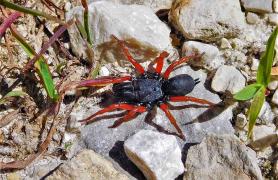
Let’s set the record straight. Bats are not flying rats, they’re not blind, they won’t get tangled in your hair, and they won’t change into vampires. Truth be told, bats are clean, shy, intelligent creatures.
Once you learn a little bit about these furry, flying, bug-munching mammals, you’ll discover that bats aren’t creepy at all.
In fact, they’re flutterly fascinating!
Show-Me Bats
Over 1,400 kinds of bats live worldwide. Most are found in tropical areas. Missouri has about 14 species, including big brown bats, eastern red bats, and gray bats.
Bats are the only mammals that can truly fly. But to stay up, bats must stay slimmed down. Missouri’s beefiest bat, the hoary bat, weighs less than a small chicken egg.
Among insect eaters, bats flutter to the top. A mama bat can gobble 100 percent of her weight in beetles, moths, and mosquitoes every night.
Better than a Bug Zapper
Bats, like this big brown bat, save U.S. farmers nearly $23 billion each year by eating insect pests.
Bat-natomy
Bats belong to a group of mammals called chiroptera (kie-rop-tair-uh), which means “hand-wing.” Indeed, a bat’s flapper has the same bones as a human’s hand. A thin but tough scrap of skin stretches across the bones. Bats fly by waving their hands. Hi!
Oops! Someone put a bat’s legs on wrong. Its knees bend backward and its heels point toward its head. When a bat hangs upside-down, special tendons keep its feet clenched. It has to flex its muscles to make its toes let go.
Flying Fluffballs
Missouri’s smallest bat is the tri-colored bat. Often mistaken for a moth, its body is 3 inches long and it weighs less than two nickels.
Acro-bat-ics
If a bat needs a breather from bagging bugs, it rests by hanging from its feet. When coming in to land, it folds up one of its wings and cartwheels upside-down, like a snowboarder doing a trick. To take off, most bats simply drop from their roosts like furry dive bombers and let gravity help them pick up enough speed to fly.
Seeing with Sound
As it flies, a bat sends out high-pitched squeaks. The squeaks hit nearby objects, bounce off of them, and return to the bat’s ears. By listening to the echoes, a bat forms a picture in its batty brain of its surroundings. The process, called echolocation (eck-oh-loh-kay-shun), is like the sonar that submarines use to navigate.
Silent Roar
A bat’s calls are among the loudest made by any animal. Fortunately, they’re too high-pitched for humans to hear. Muscles in a bat’s ears flex and relax with each burst of sound. This blocks outgoing squeaks but lets in incoming echoes. As a bat closes in on its quarry, it squeaks faster and faster — up to 200 times a second! Who knew the night sky was so noisy?
Blind at Breakfast
Many bats can’t squeak with a full mouth. While eating, their echolocation turns off, and they become momentarily “blind.”
Danger in the Darkness
Bats aren’t the only hungry hunters out after dark. Owls are known to make meals out of their fellow flyers. During the day, snakes, raccoons, and hawks pick off bats while they rest. And summer storms — especially when it rains for several nights in a row — prevent bats from catching enough food.
Bagging Bugs
A bat uses its wings and tail like a catcher’s mitt. But instead of catching curveballs, it nabs insects to eat then passes the morsels to its mouth. Eating in flight allows a bat to top off its tummy in only an hour or two.
Baby Bats
In spring, mama bats find a place to raise their babies. Gray bats use caves, but most bats find a hollow tree, cliff crevice, or attic for their nursery.
When the baby is born, mom catches it with her wings or tail. The pup is blind, hairless, and helpless. Mom licks it clean and feeds it milk.
She leaves her pup each night to hunt. When she returns, she finds her baby among the dozens of others by listening for its unique voice.
In an emergency, mom flies her baby to safety. To stay attached during flight, the pup clings to mom’s belly with its teeth. Ouch!
Her pup grows quickly and is able to fly on its own in about a month.
Mama Mia!
Newborn bats can weigh a third as much as their mom. Luckily, most moms have only one pup. Red bats, however, may have up to four.
Super Snoozers
In the fall, a bat’s thoughts turn to romance. Swarms of furry flyers gather near cave openings. These bat parties help youngsters find winter hangouts and let older bats choose girlfriends and boyfriends.
Most of Missouri’s bats hibernate during winter. In this sleep-like state, a bat’s temperature drops from 100 to about 50 degrees. Its heart slows from beating 1,000 times a minute to once every few seconds. Bats may wake up every few weeks for a drink, but most don’t eat all winter long.
A few species say, “See ya!” when winter weather arrives. Most red bats flutter south where it’s warmer. But a few stick around and snuggle under a blanket of leaves on chilly nights.
Snuggle Buddies
You can pack a boatload of bats in an itty-bitty space. Over 300 can snuggle together on a cave wall in a space no larger than this page.
Disappearing Bats
A cold-loving fungus infects hibernating bats, growing as a ghostly-white fuzz on their noses, ears, and wings. Bats with “white-nose syndrome” get thirsty and hungry, and leave their caves during winter. Eventually, many freeze or starve.
But that isn’t the only bad news for bats. Habitat loss, pesticide use, and climate change all pose dangers to bat populations.
Going to Bat for Bats
Bats need our help! Many species are decreasing in number. Some may disappear altogether. Here’s what you can do:
- Stay out of caves that don’t allow visitors. You could carry in germs that harm bats.
- Avoid using pesticides. They kill insects that bats eat.
- Don’t cut down dead trees. Bats use them for nurseries.
Build a bat house. Find plans online at batcon.org.










Also In This Issue

Plier-like pincers on the front of a scorpion clamp down on spiders, insects, and other prey.

Rarely seen but freakishly fascinating, purseweb spiders spend their lives hiding in plain sight.
And More...
This Issue's Staff
Photographer – Noppadol Paothong
Photographer – David Stonner
Designer – Marci Porter
Designer – Les Fortenberry
Art Director – Cliff White
Editor – Matt Seek
Subscriptions – Laura Scheuler
Magazine Manager – Stephanie Thurber






















